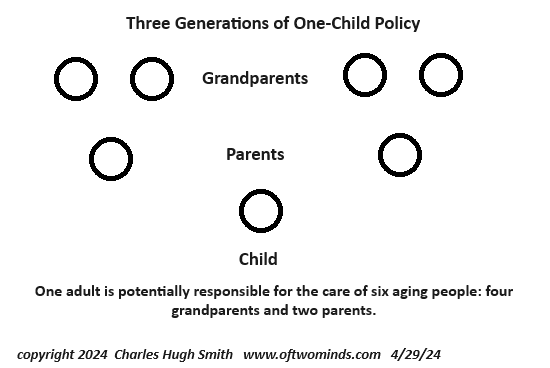China and the U.S.: What Matters That's Overlooked
Parsing geopolitics is fun but our attention is better directed to the limits and second-order effects of legacy systems in each of the rival states.
Geopolitics, like any conflict, is dramatic: rivals jostle for hegemony on a 3-D chessboard, war threatens, etc. The focus of this drama is on the leaders' calculations and the pieces being moved around the board in the complex battle for hearts, minds, resources and the high ground.
This is the conventional context of history, and so accounts of the rivalry between the Roman Empire and the Persian Empire read like contemporary accounts of the rivalry between China and the U.S.: the actors and scenery changes, but the dramatic plot remains the same.
A less dramatic but closer reading of history tells a different story: imperial decline stems not from external rivalries but from internal limitations. Externalities--plague, drought, invasion--are not causes so much as events which reveal the limits of the empire's internal legacy institutions.
These rigidities can be structural--economic or political--or cultural / social. There are two dynamics in play here:
1. Once solutions are institutionalized, they become legacy systems that focus not on flexibly solving problems but on sustaining and defending the interests of the institution and its insiders. The solution becomes the problem.
2. Whatever is viewed as a solution generates unanticipated second-order effects which the system is ill-equipped to resolve.
There are many examples of these dynamics in both China and the U.S., and indeed, in every nation / polity.
Consider the goal of increasing homeownership, a laudable ideal that the U.S. pursued after World War II by institutionalizing the heretofore unavailable innovation of 30-year fixed-rate mortgages and government-agency backed mortgages (Veteran Administration-backed mortgages for veterans, FHA, etc.).
Once the institutions promoting homeownership became self-sustaining legacy systems, they changed from "solution" to "problem." As homeownership rates reached 65% of American households, the institutional drive to increase homeownership led to the development of subprime mortgages designed for households that did not qualify for conventional mortgages.
To grease the skids, lending standards were stripped to the point of irrelevance, liar loans took center stage and ratings agencies rubber-stamped risky mortgages as low-risk.
The net result of this institutional self-serving inertia was the collapse of subprime securities and the near-collapse of the global financial system as the dominoes of default and obscured risk started falling.
Turning to China, consider this chart of what happens when a one child per family state policy is enforced for three generations:

The policy was institutionalized with a sensible goal of limiting population growth to increase living standards, but without consideration of the second-order effects down the road.
In three generations, there are four grandparents and two parents who are all single children without siblings, uncles or aunts, and a single child who could be tasked not just with caring for two aging parents but four even older grandparents, should they live beyond the ability of their own aging offspring to care for them.
China has acquired the markers of a great power--missions to the moon and Mars, a mighty military and global economic influence--but it lacks a state-funded universal social welfare system that provides a substantial pension and medical care for every retiree regardless of their employment or earnings. This leaves much of the care of China's rapidly aging generations on the shoulders of the third generation of single offspring.
As in other nations, China's birthrate has declined precipitously as the financial pressures on parents mount, especially on young mothers who desire career opportunities equal to those available to young men.
Social welfare programs become increasingly costly and burdensome as populations age. Any state-funded solution will require diverting enormous sums currently spent elsewhere to the care of a large aging cohort.
The sources of brittleness and failure that are overlooked are internal, not external. Parsing geopolitics is fun but our attention is better directed to the limits and second-order effects of legacy systems in each of the rival states.
My recent books:
Disclosure: As an Amazon Associate I earn from qualifying purchases originated via links to Amazon products on this site.
Self-Reliance in the 21st Century print $18, (Kindle $8.95, audiobook $13.08 (96 pages, 2022) Read the first chapter for free (PDF)
The Asian Heroine Who Seduced Me (Novel) print $10.95, Kindle $6.95 Read an excerpt for free (PDF)
When You Can't Go On: Burnout, Reckoning and Renewal $18 print, $8.95 Kindle ebook; audiobook Read the first section for free (PDF)
Global Crisis, National Renewal: A (Revolutionary) Grand Strategy for the United States (Kindle $9.95, print $24, audiobook) Read Chapter One for free (PDF).
A Hacker's Teleology: Sharing the Wealth of Our Shrinking Planet (Kindle $8.95, print $20, audiobook $17.46) Read the first section for free (PDF).
Will You Be Richer or Poorer?: Profit, Power, and AI in a Traumatized World
(Kindle $5, print $10, audiobook) Read the first section for free (PDF).
The Adventures of the Consulting Philosopher: The Disappearance of Drake (Novel) $4.95 Kindle, $10.95 print); read the first chapters for free (PDF)
Money and Work Unchained $6.95 Kindle, $15 print) Read the first section for free
Become a $3/month patron of my work via patreon.com.
Subscribe to my Substack for free
NOTE: Contributions/subscriptions are acknowledged in the order received. Your name and email remain confidential and will not be given to any other individual, company or agency.
|
Thank you, Peter A. ($70), for your astoundingly generous contribution to this site -- I am greatly honored by your support and readership. |
Thank you, Mark S. ($70), for your marvelously generous subscription to this site -- I am greatly honored by your support and readership. |
|
|
Thank you, Walter S. ($70), for your splendidly generous subscription to this site -- I am greatly honored by your support and readership. |
Thank you, John D. ($20), for your much-appreciated generous contribution to this site -- I am greatly honored by your steadfast support and readership. |


























